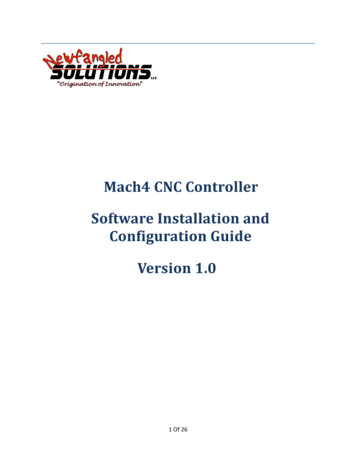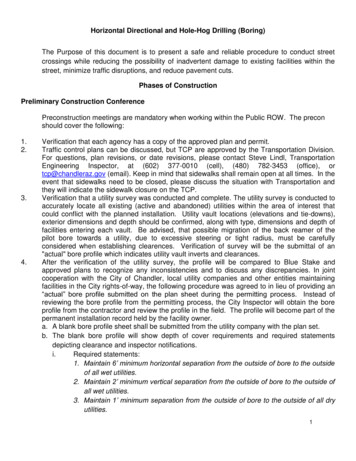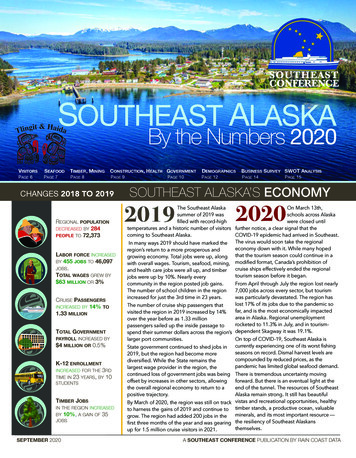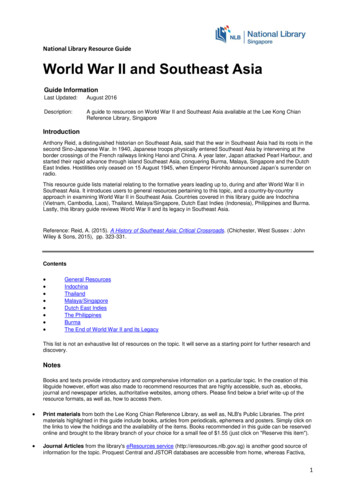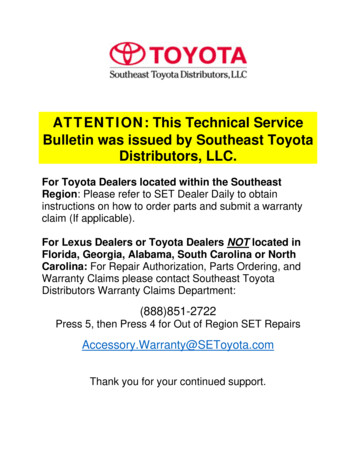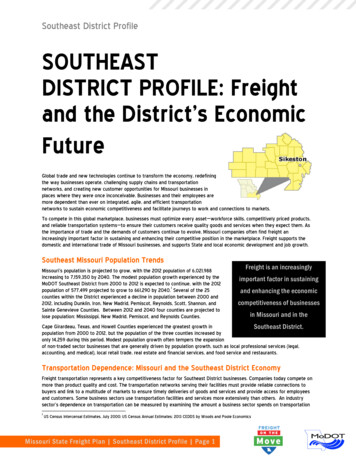
Transcription
Southeast District ProfileSOUTHEASTDISTRICT PROFILE: Freightand the District’s EconomicFutureGlobal trade and new technologies continue to transform the economy, redefiningthe way businesses operate, challenging supply chains and transportationnetworks, and creating new customer opportunities for Missouri businesses inplaces where they were once inconceivable. Businesses and their employees aremore dependent than ever on integrated, agile, and efficient transportationnetworks to sustain economic competitiveness and facilitate journeys to work and connections to markets.To compete in this global marketplace, businesses must optimize every asset—workforce skills, competitively priced products,and reliable transportation systems—to ensure their customers receive quality goods and services when they expect them. Asthe importance of trade and the demands of customers continue to evolve, Missouri companies often find freight anincreasingly important factor in sustaining and enhancing their competitive position in the marketplace. Freight supports thedomestic and international trade of Missouri businesses, and supports State and local economic development and job growth.Southeast Missouri Population TrendsMissouri’s population is projected to grow, with the 2012 population of 6,021,988increasing to 7,159,350 by 2040. The modest population growth experienced by theMoDOT Southeast District from 2000 to 2012 is expected to continue, with the 2012population of 577,499 projected to grow to 661,290 by 2040. 1 Several of the 25counties within the District experienced a decline in population between 2000 and2012, including Dunklin, Iron, New Madrid, Pemiscot, Reynolds, Scott, Shannon, andSainte Genevieve Counties. Between 2012 and 2040 four counties are projected tolose population: Mississippi, New Madrid, Pemiscot, and Reynolds Counties.Freight is an increasinglyimportant factor in sustainingand enhancing the economiccompetitiveness of businessesin Missouri and in theCape Girardeau, Texas, and Howell Counties experienced the greatest growth inSoutheast District.population from 2000 to 2012, but the population of the three counties increased byonly 14,259 during this period. Modest population growth often tempers the expansionof non-traded sector businesses that are generally driven by population growth, such as local professional services (legal,accounting, and medical), local retail trade, real estate and financial services, and food service and restaurants.Transportation Dependence: Missouri and the Southeast District EconomyFreight transportation represents a key competitiveness factor for Southeast District businesses. Companies today compete onmore than product quality and cost. The transportation networks serving their facilities must provide reliable connections tobuyers and link to a multitude of markets to ensure timely deliveries of goods and services and provide access for employeesand customers. Some business sectors use transportation facilities and services more extensively than others. An industrysector’s dependence on transportation can be measured by examining the amount a business sector spends on transportation1US Census Intercensal Estimates, July 2000; US Census Annual Estimates; 2013 CEDDS by Woods and Poole EconomicsMissouri State Freight Plan Southeast District Profile Page 1
Southeast District Profileas a share of its total output. 2 Transportation satellite accounts provide national data regarding the amount spent ontransportation per dollar of output for various sectors.To better understand the role freight and goods movement play in the Southeast District and the contribution of multimodaltransportation to the economic vitality of the District’s key industry sectors, the project team evaluated the importance ofthese key industrial sectors based on the non-government employment concentrations in the District. Almost 75 percent of theDistrict’s non-government employment is concentrated in 10 sectors: health care and social services, retail and wholesale trade,manufacturing, accommodation and food service, other services, administrative services, finance and insurance, construction,transportation and warehousing, and farm employment. 3 Figure 1 shows the breakdown of these employment sectors, bypercentage, for the Southeast District and for the State of Missouri.Figure 1: Top Ten Non-Government Employment Sectors, Southeast DistrictAs noted in Figure 1, the importance of transportation to these key industry sectors can be measured by the amount eachsector spent on transportation as a share of its total output.The project team evaluated several primary industry sectors and identified the corresponding industrial classification codes foreach key sector in order to compare the applicable transportation costs per dollar of product output using the transportationsatellite accounts research. Key business sectors for the Southeast District are shown in Table 1.Table 1: North American Industrial Classifications for Key Industrial Sectors, Southeast DistrictIndustrial SectorsNorth American Industrial Classification SectorVineyards and WineriesAgricultureCargo-Oriented DevelopmentTransportation and WarehousingPlastics and Rubber ProductsManufacturingMachine ManufacturingManufacturingRetail and Wholesale TradeRetail and Wholesale TradeAgriculture and ForestryAgriculture2“Transportation3Satellite Accounts: A Look at Transportation’s Role in the Economy,” U.S. DOT Research and Innovative Technology AdministrationBureau of Labor Statistics, US Census 2012, County Business PatternsMissouri State Freight Plan Southeast District Profile Page 2
Southeast District ProfileFigure 2 shows the transportation cost per dollar of product output for several important existing industry sectors in theSoutheast District based on their NAICS code. Improvements in transportation costs and services would have a significanteffect on the profitability of companies in these industries, as lower transportation costs and more reliable service help reducethe cost of materials, resulting in lower overall production costs. Reliable delivery of materials can enhance productivity, andreducing distribution costs to the consumer may also improve competitiveness.Figure 2: Transportation Cost as a Share of Sector Output.(Transportation cost per of product value)Natural Resources & MiningManufacturingProfessional & Business ServicesWholesale & Retail TradeTransportation and WarehousingTransportation Equipment and PartsAgriculture & Forestry 0.00 0.05 0.10 0.15Cost per Dollar of Product OutputSource: Transportation Satellite Accounts database, Bureau of Transportation Statistics,Research and Innovation Technology AdministrationThe Southeast District has been successful in retaining and attracting transportation-dependent businesses in severalsignificant economic sectors as described in Table 2:Table 2: Economic Sectors the Southeast District has retained and attracted transportation-dependent ngChemicalManufacturingInvensys ControlsSRG GlobalNoranda AluminumTG MissouriNordyneBriggs & StrattonEllington Industrial SupplyRoyal Oak EnterprisesSpectrum BrandsMondi Jackson Inc.Procter & GambleMissouri State Freight Plan Southeast District Profile Page 3
Southeast District ProfileEconomic Development TrendsThe Missouri Economic Research and Information Center (MERIC) reported the statewide average rate for the formation of newbusinesses increased by 0.1 percent in 2013, to 2.8 percent new businesses per 1,000 residents. 4 The counties in the MERICSoutheast and South Central region, which includes most of the MoDOT Southeast District, continued to lead the State in thismetric. In particular, MERIC’s Southeast region had a higher share of startups in manufacturing and in transportation andwarehousing businesses than other parts of the State.Cargo-Oriented DevelopmentMERIC also predicts strong job openings in freight-related occupations in the state between 2012 and 2022. 5 Heavy and tractortrailer truck drivers are expected to account for 1,475 job openings and 1,757 openings are anticipated for freight, stock, andmaterial movers. Both of these figures include growth as well as replacement positions due to retirement, turnover, andworkers shifting to other industries. Transportation and warehousing is listed as a top industry for employment in theSoutheast District between 2011 and 2040, with projected job growth of 40.6 percent. 6 However, as of August 2014 anationwide shortage of truck drivers means as many as 40,000 openings are not being filled. Truck drivers are third on the listof ManpowerGroup’s 2013 Talent Shortage Survey, and the shortage is expected to intensify as demand grows for shipping viatruck and drivers retire; the average age for truck drivers nationwide in 2014 is 50. 7Plastics and Machine ManufacturingManufacturing accounted for almost 16 percent of all non-farm jobs in the Southeast region in 2008, though both the number ofmanufacturing firms and manufacturing jobs declined during the 2007-2009 recession. Still, both plastics and rubbermanufacturing and machine manufacturing remain significant industries in the area. As the global economy recovers, analystsexpect “quite impressive” growth in the worldwide market for industrial machinery between 2014 and 2018, 8 driven byconsumer products such as cars and food as well as oil and gas exploration, construction, and green energy. Annual growth isprojected to be 6.3 percent in 2014 (more than double the 2.9 percent increase seen in 2013) and growth should averagebetween five and six percent between 2014 and 2018.The year-over-year output of the U.S. plastics industry grew by six percent in the second quarter of 2014, largely due to strongdemand from the durable goods and motor vehicles sectors. This trend is projected to continue through 2015, and plastics firmsin the Southeast District are expected to share in this growth. Although automobile manufacturing declined during the recentrecession, a number of auto suppliers in Missouri announced significant expansions in 2012 and 2013. 9 TG Missouri is expandingits plant in Perryville to add a new production line that will supply chrome and plastic components to Toyota. The 38.9 millioninvestment will add 200 jobs.A recent survey by the National Association of Manufacturers 10 found that three fourths of respondents across the U.S. werestruggling to find qualified workers, and 88 percent cited a lack of skills as the reason. According to the survey, firms haveincreased employee training and many now rely on technical and community college programs to provide the workers theyneed to maintain and grow their businesses. A local example is the partnership announced in 2013 between SRG Global inPortageville, one of the world’s largest manufacturers of chrome-plated plastic auto parts, and Three Rivers CommunityCollege. State funding from the state’s Community College Job Retention Training Program will be used to enhance the skills of350 SRG employees.Transportation equipment, chemicals (including plastics), and machinery were the three top Missouri exports to Canada in 2013.Canada is already the largest importer of Missouri goods, and trade discussions with several Canadian provinces in 2014 pointto increases in exports of Missouri products. The State has signed trade agreements with Quebec, Korea, Taiwan, China, Brazil,and several European countries to sell 9.7 billion in Missouri products over the next four years, according to the Governor’soffice. 11Agriculture and ForestryAgriculture and forestry provide significant jobs in Southeast Missouri. Rice, soybeans, corn, and cotton are grown in the eastern4MERIC, 2013 Business Formations5MERIC, Missouri’s Top Openings 2012-20226Woods and Poole7Williams, G. Chambers. “Trucking industry faces uphill battle to recruit drivers.” The Tennesseean, August 25, 2014.8Jonathan Cassell, IHS Technology. “Rise of the Machines: Industrial Machinery Market Growth to Double in 2014.” April9http://governor.mo.gov/news/, accessed August 27, 201410“Mind the Gap,” Member Focus, the newsletter of the National Association of Manufacturers, May 201311http://governor.mo.gov/news/archiveMissouri State Freight Plan Southeast District Profile Page 416, 2014.
Southeast District Profilepart of the region, and exports of these crops continue to grow as demand for U.S.-produced agricultural products increases.Missouri’s food and food ingredient exports increased 148 percent between 2005 and 2011. 12 A number of smaller farms, facingincreasing competition from corporate growers, have turned to specialty crops. The Southeast District is home to a rapidlygrowing wine industry, with 46 vineyards and wineries in Southeast Missouri listed by the Missouri Grape Growers Associationin 2013. Most of these are in Ste. Genevieve County. The Mississippi River Hills Association aims to strengthen the region’seconomy by supporting specialty agriculture and related tourism markets.Wood products form another industry cluster in the south central area of the State. The region is a leading U.S. producer ofwood pallets, which fits well with the State’s status as a logistics hub. Demand for pallets should remain strong with theFederal Highway Administration projecting U.S. freight will double by 2020.Retail and Wholesale TradeJob opportunities in retail trade are expected to be above average between 2012 and 2022. Cashiers are projected to have themost openings of any occupation at 3,358 and retail salespersons will have 2,097 openings. 13 In 2011 retail trade accounted foralmost 12 percent of the District’s jobs. Though internet sales will continue to compete with brick-and-mortar stores, bothdepend on efficient freight transportation to get their products in the hands of consumers. Wholesale trade is also important tothe economy of the Southeast District, providing more than three percent of jobs in 2011. Growth is anticipated in bothwholesale and retail trade in the next few years as the country and the world recover from the recent global recession.Importance of Freight to the Economic Development Future of the SoutheastDistrictManufacturing and ExportsManufacturing continues to be a vital part of Missouri’s economy and exports of Missouri manufactured goods continue toincrease. Missouri businesses exported over 3 billion in goods by the close of the first quarter of 2014, and nearly 13 billion in2013. 14,15 Four primary industries in the manufacturing sector accounted for over 62 percent of Missouri exports: transportationequipment, chemicals, food and kindred products, and machinery related businesses. These industries exported over 8 billionin products in 2013. 16 Agricultural products, fabricated metal products, electrical equipment, minerals and ores, primary metalmanufacturing, and computer and electronic products round out the top 10 exports from the State in 2013. Over 6,100businesses in Missouri exported products and services in 2012, and 89.5 percent of Missouri’s exports are manufactured goodsproduced in communities around the state. Manufacturing exports support nearly 107,000 jobs in the State, and 85 percent ofthe companies engaged in exporting goods and services are small businesses. 17Manufacturing matters in Missouri because:1213 Employees in manufacturing firms earn an average of 77,060 annually in pay and benefits, while average workers inall industries earn 60,168. This means manufacturing jobs pay, on average, 19.9 percent more than non-manufacturingjobs. 18 Manufacturing firms account for nearly two-thirds of all research and development in the U.S. and are a leading userof new technologies and processes. 19 Manufacturing has the highest multiplier effect of any economic sector. For every dollar spent in manufacturinganother 1.48 is added to the economy, helping to stimulate economic growth. Missouri’s economy is intrinsically linked to its ability to move people, materials, components, and finished goodswithin the State and to national and international destinations. Missouri’s principal trading partners are Canada, Mexico, China, Japan, and Korea. 20 The five industries with the mostsignificant job dependence on exports include grain farming, oilseed farming, wholesale trade, and aircraftwww.missouripartnership.comMERIC, Missouri’s Top Openings 2012-202214WISER Export Trade data, 201415U.S. Census Freight Trade State Exports, Missouri16Missouri Economic Research and Information Center, Missouri Department of Economic Development, March 201317U.S. Department of Commerce, International Trade Administration, National Association of Manufacturing, 201318Bureau of Economic Analysis, Industry Economic Accounts, 201119Brookings Institute, Metropolitan Policy Program, “Why Does Manufacturing Matter?” February 2012Missouri State Freight Plan Southeast District Profile Page 5
Southeast District Profilemanufacturing. Agriculture continues to play a significant role in the Southeast District’s economy. The district hasexperienced growth in grape products, vineyards, and wineries, and in sunflowers, grains, oilseeds, and organicvegetables. The number of farms in the region has increased since 2002 as technological advances have madefarming more productive and profitable. 21 Export products are intrinsically dependent on multimodal freight transportation.ConclusionMoDOT’s Southeast District has a diverse economy, and the outlook for the future is promising. In addition to the TG Missouriplant expansion mentioned above, Noranda Aluminum will spend 45 million to enlarge its smelting operation in New Madrid.Investments in manufacturing such as these will add jobs to the area, both directly and indirectly. Strong demand for theregion’s corn, soybeans, rice, cotton, and wood products as well as the growing wine industry will enable the agriculture sectorto continue to contribute to the area’s economy as well. The increased demand for Southeast Missouri agricultural products andmanufactured goods will, in turn, drive growth in the freight and warehousing industry, resulting in more jobs for truck drivers,freight handlers, and logistics experts. Finally, employment growth in all of these sectors will contribute to the predictedincreases in population—and more residents means higher demand for consumer products that must be delivered to localstores and homes throughout the District.All of this depends on a dependable, efficient freight network. Manufacturers of plastics, machinery, and other products dependon the statewide freight infrastructure to deliver raw materials and components and to carry finished products to assemblyplants, distributors, and end users. Farms that grow rice, cotton, corn, and soybeans rely on the District’s rail, highway, andwater ports to deliver their output to markets across the country and around the world. Along with smaller farm operationsand the growing winemaking sector, they also depend heavily on the District’s many secondary roadways to link them with thebroader transportation network. Businesses also rely on these secondary roads for time-sensitive deliveries, and trucks of allsizes use them to supply grocery stores, offices, building sites, and homes with the goods, materials, and products they needevery day. Research shows that investing in physical infrastructure reduces costs and improves efficiencies in conductingbusiness, boosts job creation, and fosters growth cycles within countries. 22 Based on this research, maintaining the existingfreight system and expanding both its capacity and its connections in ways that increase reliability and reduce costs are criticalto the future prosperity of the businesses and residents of the Southeast District.202122US Census, State Exports, Foreign Trade, 20132010 Census of Agriculture, USDA, Southeast Missouri Regional Planning and Economic Development DistrictDeloitte LLP and the Council on Competitiveness, “2013 Global Manufacturing Competitiveness Index”Missouri State Freight Plan Southeast District Profile Page 6
Southeast District 6between 2011 and 2040, with projected job growth of 40.6 percent. However, as of August 2014 a . A recent survey by the National Association of Manufacturers. 10. found that three fourths of respondents across the U .S. were struggling to find qualified workers, and 88 percent cited a lack of skills as the reason. .

